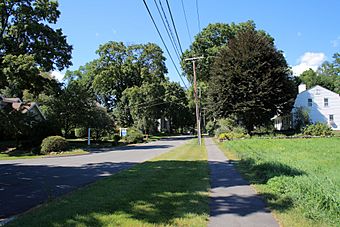Farmington Historic District (Farmington, Connecticut) facts for kids
Quick facts for kids |
|
|
Farmington Historic District
|
|

A view of Farmington Center
|
|
| Location | Farmington, Connecticut |
|---|---|
| Area | 275 acres (111 ha) |
| Architect | Woodruff, Judah |
| Architectural style | Greek Revival |
| NRHP reference No. | 72001331 |
| Added to NRHP | March 17, 1972 |
The Farmington Historic District is a very special part of Farmington, Connecticut. It covers about 275 acres (111 hectares) in the town center. This area was added to the National Register of Historic Places in 1972. This means it's officially recognized as important for its history and buildings.
The district includes many old buildings, mostly homes, that were built before 1835. You can find it along a section of Route 10, between Route 4 and U.S. Route 6. There are 115 buildings here that tell stories of the past.
Contents
Exploring Farmington's History
Farmington is a town with a long history. It was first settled by people in 1640. Just five years later, in 1645, it officially became a town. For a while in the 1700s, Farmington was a very busy place. It had lots of trade and different kinds of businesses. It was almost as important as Hartford back then!
The Farmington Canal Era
In the early 1800s, Farmington got another boost. The Farmington Canal was built right through the town. This canal was like an old-fashioned highway for boats. It helped move goods and people. The canal brought more visitors and business to Farmington.
A famous building from this time is the Union Hotel. It was built around 1830 from brick. This hotel was made to welcome travelers using the canal. Today, this historic building is used by Miss Porter's School for its offices.
Why Farmington Looks So Old
Farmington's main street was planned out a very long time ago. It still looks much like it did centuries ago. This is partly because of a change in transportation. When railroads became popular, they mostly bypassed Farmington. This meant the town's economy slowed down. The canal also became less important. Because of this, many new buildings weren't built. This helped Farmington keep its historic look.
Famous Buildings and Builders
Many of the district's beautiful buildings were constructed by Judah Woodruff. He was a well-known builder in the area. One of his most important works is the First Church of Christ, Congregational. It was built in 1771.
This church is one of the few colonial-era churches left in Connecticut. It's special because it still has its original design. The main entrance and the pulpit (where the speaker stands) are on the long sides of the building. This was a common style back then, but few examples remain today.
National Historic Landmarks
The Farmington Historic District is home to several National Historic Landmarks. These are places that are extra important to the history of the United States. They include:
- Hill-Stead
- The Austin F. Williams Carriagehouse and House
- The First Church of Christ, Congregational
- The Stanley-Whitman House
These landmarks help us understand what life was like in early America. They are carefully preserved for everyone to learn from and enjoy.



